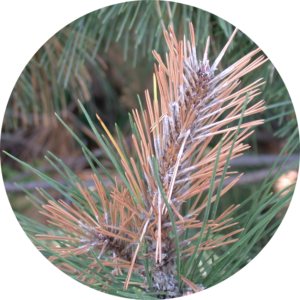Tip Blight

Tip blight (or shoot blight) is a fungal disease that primarily affects pine trees, although spruce and fir trees are also susceptible. It develops as a result of a tree becoming weakened due to factors such as drought and root restriction. The disease largely afflicts trees 15 years and older, although it also attacks very young seedlings. The older the tree, the more likely it is to be negatively affected by tip blight.
The infection begins in the needles, moves upward into the branches’ tips, and weakens the tree in the process. This lowers the tree’s resistance, leaving it open to attack from other diseases and pests. Needles suffering from tip blight turn from yellow to brown before dying.
Maintaining healthy trees is one of the best ways to avoid the development of tip blight. Regular fertilization, proper watering practices during dry periods, and insect control are just a few of the ways to help keep trees in great shape. If a tree does have some blighted shoots, remove and dispose of them. However, infected trees should not be pruned during wet weather; spores released at this time might cling to pruning tools, which in turn might affect other trees on which they are used. If you suspect a tool may have come into contact with spores, disinfect it by using alcohol or bleach.
The use of fungicide may also aid in controlling the disease. Apply immediately before bud break and continue applications at 10-day intervals thereafter.

